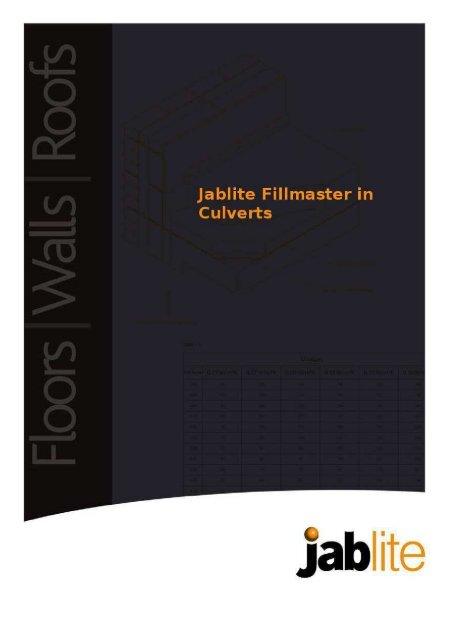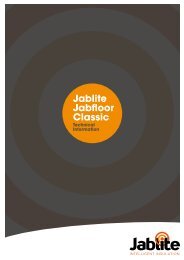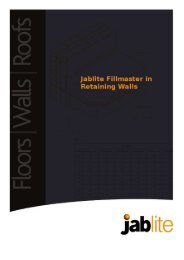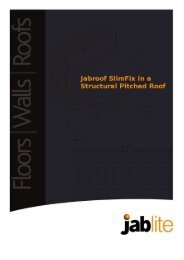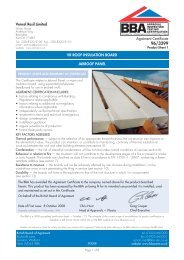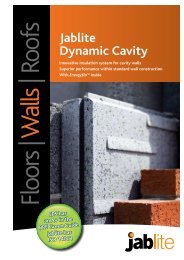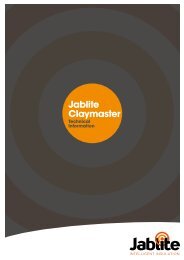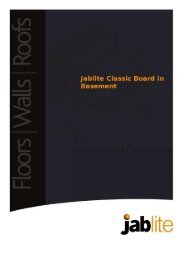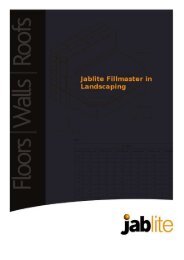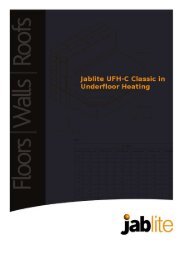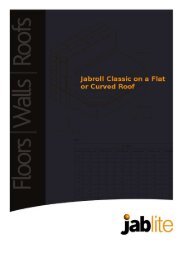Jablite Fillmaster in Culverts
Jablite Fillmaster in Culverts
Jablite Fillmaster in Culverts
- No tags were found...
Create successful ePaper yourself
Turn your PDF publications into a flip-book with our unique Google optimized e-Paper software.
8Design ConsiderationTraditional fill materials used to construct new embankments orplaced aga<strong>in</strong>st civil eng<strong>in</strong>eer<strong>in</strong>g structures, can cause unacceptablevertical and/or horizontal stresses <strong>in</strong> the underly<strong>in</strong>g soil or aga<strong>in</strong>stthe structure. The use of <strong>Fillmaster</strong> expanded polystyrene as a fillmaterial offers a reliable, cost-effective lightweight solution tothese problems, reduc<strong>in</strong>g the probability of further settlement orunacceptable lateral forces and often simplify<strong>in</strong>g the construction.Vencel Resil manufactures <strong>Fillmaster</strong> expanded polystyrene (EPS) blocksfor use <strong>in</strong> civil eng<strong>in</strong>eer<strong>in</strong>g projects, especially road construction. Thematerial is available <strong>in</strong> a range of sizes and strength grades. The cellularstructure of the EPS material gives a high strength-to-weight ratioensur<strong>in</strong>g that the blocks are able to withstand the mechanical loadsencountered <strong>in</strong> road construction.Advantages■ Lightweight and easy to handle on site. Approximately 1% of theweight of traditional fill materials.■ Available <strong>in</strong> a range of grades allow<strong>in</strong>g the appropriate compressivestrength to be chosen to suit each particular application.■ Closed-cell structure <strong>in</strong>hibits water absorption.■ Unaffected by normal range of climatic conditions.■ Immune to <strong>in</strong>sect, bacterial and fungal attack.Descri ptionGrade<strong>Fillmaster</strong> is supplied <strong>in</strong> the grades shown <strong>in</strong> Table 1. Normally suppliedas Euroclass F def<strong>in</strong>ed to BSEN 14933: 2007, it is also available asEuroclass E, flame-retardant additive material, if required.Dimensions<strong>Fillmaster</strong> standard block size:2440 x 1220 x 610mm; other sizes available to order to reduce theneed for cutt<strong>in</strong>g to size on site. The stability of a lightweightembankment depends greatly on the uniformity of the blocks.Tolerances: ±3mm on thickness; ±4mm on width; and ±6mm onlength. Maximum bow, 5mm over length of block.ApplicationExpanded polystyrene has been successfully used as a fill material forhighway embankments s<strong>in</strong>ce 1972. Its first such use <strong>in</strong> the UK was <strong>in</strong>1985. The material is particularly beneficial <strong>in</strong> the follow<strong>in</strong>g situationswhere its use will obviate the need for either specialised foundations,or long surcharge periods designed to preload the ground and reducesettlement problems follow<strong>in</strong>g construction:■ Areas adjacent to exist<strong>in</strong>g embankments.■ Areas of unstable ground.■ Areas of weak or compressible soil.■ Sites where access is difficult or restricted.■ Ransition zones between bridges or underpasses and normal fillmaterials.Figure 1. HA Load<strong>in</strong>gs<strong>Fillmaster</strong>blocksPavementconstructionBuoyancyReduceddeadload ofstructureCompactedsand-levell<strong>in</strong>gcourse
9Table 1Physical Properties – <strong>Fillmaster</strong>Design<strong>Fillmaster</strong> Grade FM50 FM70 FM100 FM150 FM200 FM250 FM300 FM350 FM400 FM500CompressiveStress at 1%stra<strong>in</strong> (kPa)Embankment forcesThere are three ma<strong>in</strong> design considerations when construct<strong>in</strong>gembankments us<strong>in</strong>g <strong>Fillmaster</strong>:10 20 45 70 90 100 120 140 160 190■ Downward pressure due to wheel load<strong>in</strong>gs and the self-weight of theembankment.■ Upward forces due to buoyancy <strong>in</strong> wet conditions.■ Lateral forces act<strong>in</strong>g aga<strong>in</strong>st abutments.Wheel load<strong>in</strong>gsIn order to avoid unacceptable deflections and permanent deformationof the highway surface, the compressive stresses due to wheel load<strong>in</strong>gs,etc., should be carefully calculated and the appropriate grade of<strong>Fillmaster</strong> selected to ensure that these fall with<strong>in</strong> the designcompressive strength of the material. It is recommended that this iscarried out <strong>in</strong> accordance with the method of calculation for thethickness of sub-base/subgrade set out <strong>in</strong> BS 5400. This uses theconvention of ‘HA’ and ‘HB’ units of load<strong>in</strong>g.HA load<strong>in</strong>g assumes a s<strong>in</strong>gle 100kN wheel load exert<strong>in</strong>g a pressure of1110kPa over a square of 300 x 300mm; the pressure is exerteddownwards at a gradient of 2:1. This represents the effects of normallypermitted vehicles.Design ConsiderationHB load<strong>in</strong>g represents the effects of abnormal loads on motorways andtrunk roads. It is usual to design for 45 units of HB load<strong>in</strong>g; thisrepresents the effect of 16 wheel loads each of 112.5kN exert<strong>in</strong>g apressure of 1110kPa over a square of 318 x 318mm. The pressure isdispersed downwards at a gradient of 2:1.See Figures 2 and 3.Figure 2. HA Load<strong>in</strong>gsDepth <strong>in</strong> metresbelow surface10070452721S<strong>in</strong>gle nom<strong>in</strong>alwheel HA load<strong>in</strong>g1 x 100kNFigure 3. HB Load<strong>in</strong>gsDepth <strong>in</strong> metresbelow surface4 x 112.5 4 x 112.5 4 x 112.5 4 x 112.5Approx pressure kN/m 245 Units ofHB Load<strong>in</strong>gFor technical <strong>in</strong>formation 0870 444 8769 technical@vencel.co.uk
10Design ConsiderationDownward pressureWhen calculat<strong>in</strong>g the self-weight of <strong>Fillmaster</strong> blocks an allowanceshould be made for water absorption of less than 1% by volume.This gives a design weight of approximately 100kg/m 3 .Buoyancy pressuresEPS is a proven flotation material and exerts a flotation force of900kgf/m 3 .This takes <strong>in</strong>to account a potential level of water absorption of 8% forblocks which are permanently submerged.Care must be taken dur<strong>in</strong>g the design process to ensure that thepotential flotation forces can be accommodated with<strong>in</strong> thehydrological conditions of the site and take account of the self weightof the permanent structure.Alternatively, the material can be <strong>in</strong>stalled above the water table.The water table can be lowered by <strong>in</strong>stall<strong>in</strong>g suitable cut-off dra<strong>in</strong>s atthe toe of the embankment or beneath the embankment itself.Lateral pressuresWhen us<strong>in</strong>g <strong>Fillmaster</strong> for approach embankments to bridgeabutments, the horizontal forces exerted on the abutment are almosteradicated. This allows economies to be made <strong>in</strong> the design of bridgefoundations, which are no longer required to resist large rotationalmoments.InstallationConstruction of the embankment should proceed as follows:Levell<strong>in</strong>g course<strong>Fillmaster</strong> blocks are placed on a levell<strong>in</strong>g course consist<strong>in</strong>g of a layer ofcompacted sand to a maximum thickness of 100mm. This courseshould be laid to a level tolerance not exceed<strong>in</strong>g ±10mm over any 3mlength. On sites which have very soft foundations, a geotextile layermay be placed on top of the soft soil before plac<strong>in</strong>g the sand fill, thisprevents the sand from be<strong>in</strong>g ‘punched’ <strong>in</strong>to the soil.Lay<strong>in</strong>g the blocksThe blocks <strong>in</strong> each layer should be laid with broken jo<strong>in</strong>ts; there shouldbe no vertical or horizontal jo<strong>in</strong>ts runn<strong>in</strong>g through the construction.There is no need to compact the blocks dur<strong>in</strong>g construction.The coefficient of friction (µ) between adjacent blocks can be taken as0.5; this is normally sufficient to prevent any slippage or movement.When required, for example at the edges of the embankment,a positive fix<strong>in</strong>g can be obta<strong>in</strong>ed by driv<strong>in</strong>g 12mm diameter re<strong>in</strong>forc<strong>in</strong>gbars down through the layers.The f<strong>in</strong>al profile of the side slope will depend on the properties of thesoil used. Where soil conditions restrict the available space for anembankment, a range of techniques is now available for construct<strong>in</strong>gsteep sides or vertical faces.Cutt<strong>in</strong>gBlocks which require trimm<strong>in</strong>g can be easily cut us<strong>in</strong>g a hot-wire cutter,handsaw or cha<strong>in</strong> saw.ProtectionThe <strong>Fillmaster</strong> should be protected from possible accidental contactwith petroleum or solvents us<strong>in</strong>g a suitable polymer barrier, wherenecessary.Fill or capp<strong>in</strong>g layerThe f<strong>in</strong>al fill should be placed over the <strong>Fillmaster</strong> blocks tak<strong>in</strong>g care notto puncture any membrane.No construction plant, other than compaction equipment, should bedriven across, or placed on the <strong>Fillmaster</strong> until there is a m<strong>in</strong>imumcover of 200mm of acceptable fill material, or until the capp<strong>in</strong>g layerhas been placed.Vibratory compaction plant should not be used with<strong>in</strong> 500mmvertically, or 2m laterally, of the <strong>Fillmaster</strong> blocks.CoverThe sides of the <strong>Fillmaster</strong> blocks should be covered with general filland compacted <strong>in</strong> layers. The sides should be graded and covered withtop soil. The m<strong>in</strong>imum cover should be 300mm.ReferencesBS 5400 Steel, concrete and composite bridges. Part 2 Specification for loads. Department of Transport Standard BD 37/88. Loads for highway bridges.Geotechnical considerations and techniques for widen<strong>in</strong>g highway earthworks. Department of Transport.Plastic foam <strong>in</strong> road embankments. Proceed<strong>in</strong>gs of the conference of the Norwegian Plastics Federation. June 1985.TRL Contractor report 356. The use of polystyrene for embankment construction.
11Design ConsiderationFor technical <strong>in</strong>formation 0870 444 8769 technical@vencel.co.uk
20<strong>Culverts</strong><strong>Culverts</strong> and bridges may be unable to susta<strong>in</strong> the additional load<strong>in</strong>gof <strong>in</strong>creased vehicle weight limits, lead<strong>in</strong>g to the requirement tostrengthen or replace the structures. <strong>Fillmaster</strong>, when used toreplace the surround<strong>in</strong>g heavier fills, can reduce loads and preventthe need for structural improvements.Figure 12. <strong>Culverts</strong><strong>Fillmaster</strong> blocksPavement constructionSand-levell<strong>in</strong>g courseReduced loads on culvert structure
21Figure 13. <strong>Culverts</strong><strong>Culverts</strong>Pavement construction<strong>Fillmaster</strong> blocksSand-levell<strong>in</strong>g courseM8 Extension – Claylands to Ed<strong>in</strong>burgh City bypassTo enable the construction of two connect<strong>in</strong>g slip roads it wasnecessary to widen an exist<strong>in</strong>g underpass by 20m either side of theexist<strong>in</strong>g Ed<strong>in</strong>burgh City bypass. As the orig<strong>in</strong>al structure had beendesigned to carry only the fill which formed side slopes, it wasnecessary to consider the additional imposed loads. Rather thanstrengthen or replace the exist<strong>in</strong>g structure, it proved economicalsimply to reduce the dead loads by <strong>in</strong>corporat<strong>in</strong>g <strong>Fillmaster</strong> <strong>in</strong> thedesign.The reduction <strong>in</strong> dead loads act<strong>in</strong>g on the structure by us<strong>in</strong>ga fill with a density of less than 30kg/m 3 , enabled the liveloads to be <strong>in</strong>creased with no detrimental effect to the extendedstructure.In all, 2,000m 3 of <strong>Fillmaster</strong> blocks were used <strong>in</strong> three grades to replacestructural backfill on a 30m stretch of the road. The 2440 x 1220 x610mm blocks were delivered on vehicles carry<strong>in</strong>g 70-100m 3 per loadenabl<strong>in</strong>g rapid construction without the need for compaction.Construction of M8 extension, Ed<strong>in</strong>burgh City bypassClient: Scottish OfficeDesign: W.A. FairhurstContractor: Balfour BeattyVolume: 2,000m 3For technical <strong>in</strong>formation 0870 444 8769 technical@vencel.co.uk
44Technical DataTable 5. Physical Properties – <strong>Fillmaster</strong>Physical Properties - <strong>Fillmaster</strong><strong>Fillmaster</strong> Grade FM50 FM70 FM100 FM150 FM200 FM250 FM300 FM350 FM400 FM500CompressiveStress at 1%stra<strong>in</strong> (kPa)10 20 45 70 90 100 120 140 160 190Biological propertiesEPS is not susceptible to attack by fungus or bacteria and isnon-biodegradable. It offers no nourishment to vegetation oranimal life.Chemical resistanceEPS is resistant to most substances which occur naturally <strong>in</strong> soil, as wellas to a wide range of common substances at ambient temperatures,<strong>in</strong>clud<strong>in</strong>g:■ alkalis■ dilute <strong>in</strong>organic acids■ gypsum plaster■ most alcohols■ portland cement■ silicone oil■ solvent-free bitumenIf there is any possibility that the soil with which it is likely to come<strong>in</strong>to contact is contam<strong>in</strong>ated, for example when construct<strong>in</strong>gembankments on reclaimed <strong>in</strong>dustrial land, laboratory tests should beconducted to determ<strong>in</strong>e the exact nature of the contam<strong>in</strong>ants. Somematerials, <strong>in</strong>clud<strong>in</strong>g vegetable oils, paraff<strong>in</strong>, animal fats and oils mayattack the surface of the EPS caus<strong>in</strong>g shr<strong>in</strong>kage and deformation.However, they are not able to dissolve the EPS nor to penetrate themass of the material and do not affect long-term stability.DurabilityWhen correctly specified and <strong>in</strong>stalled as a lightweight embankmentfill, <strong>Fillmaster</strong> can be considered as a permanent material. <strong>Fillmaster</strong>also has the added advantage of be<strong>in</strong>g floor-proof.Mechanical propertiesEPS behaves as a l<strong>in</strong>ear elastic material up to stra<strong>in</strong>s of 1% where theelastic limit is exceeded. A typical stress stra<strong>in</strong> curve is shown <strong>in</strong> Graph3. <strong>Fillmaster</strong> creep deformation can be disregarded <strong>in</strong> embankmentapplications.The coefficient of friction (µ) between blocks is around 0.5 along themoulded faces; the figure is higher on cut faces s<strong>in</strong>ce the surfaceroughness is <strong>in</strong>creased.Poissons ratio 0.02.Moisture propertiesEPS is not soluble <strong>in</strong> water and will not usually exceed a moistureabsorption level of 8-10% after long-term immersion.The closed-cell structure prevents the migration of liquids through themass of the material.Graph 2. Typical stress stra<strong>in</strong> curveEPS should not allowed to come <strong>in</strong>to contact with hydrocarbons,chlor<strong>in</strong>ated hydrocarbons, organic solvents such as ketones, ethers andesters; diesel and petroleum fuels; and concentrated acids.If there is any possibility of contact with these substances, eitherdur<strong>in</strong>g or after construction, the material should be protected by us<strong>in</strong>gan impermeable polymer membrane as a physical barrier. Further<strong>in</strong>formation is available from Vencel Resil’s technical servicesdepartment.Stress1 Stra<strong>in</strong> (%)10
45Fire<strong>Fillmaster</strong> is normally supplied as Euroclass F material as def<strong>in</strong>ed <strong>in</strong>BS EN 14933: 2007; Euroclass E, flame-retardant additive material isalso available. EPS will ignite on contact with an open flame and willburn readily <strong>in</strong> the presence of air. Care should be taken dur<strong>in</strong>gconstruction to ensure that the material is not exposed to possiblesources of ignition. The use of the flame-retardant additive material will<strong>in</strong>hibit the early stages of the development of a fire.Small quantities of residual blow<strong>in</strong>g agent may be present and adviceshould be sought from Vencel Resil’s technical services departmentwhen <strong>in</strong>corporat<strong>in</strong>g the product <strong>in</strong> areas of low natural ventilation.Fire is not normally a hazard once the material has been placed andcovered.CombustionEPS is ‘combustible’ as def<strong>in</strong>ed <strong>in</strong> BS 476:Part 4. When burn<strong>in</strong>g,EPS behaves like other hydrocarbons such as wood and paper.For Euroclass F material, the products of uncontrolled combustion arecarbon monoxide, carbon dioxide, styrene, and water vapour; thedecompos<strong>in</strong>g styrene will emit a certa<strong>in</strong> amount of dense black soot.Euroclass E material also emits hydrogen bromide when burn<strong>in</strong>g.Ignition temperatureFlash ignition temperature is between 350 and 490ºC depend<strong>in</strong>g onthe application and the exact circumstances of use. Under certa<strong>in</strong>circumstances the material can be readily ignited by a naked flame,but provid<strong>in</strong>g it is correctly <strong>in</strong>stalled this does not present anydisadvantage <strong>in</strong> use.Calorific value: 40MJ/kg.Specific heat capacity: 1.13kJ/kgºC.Environmental issuesEPS does not conta<strong>in</strong> or produce HCFCs, nor are these compounds used<strong>in</strong> its manufacture. In use, it is non-toxic, non-irritant and odourless.Due to the high volume and low weight of a lorry load of <strong>Fillmaster</strong>there are environmental advantages over traditional materials <strong>in</strong>reduc<strong>in</strong>g the number of lorry runs required to supply a contract.This can be particularly advantageous <strong>in</strong> built-up environments.(90m 3 of EPS compared to typically 10m 3 of traditional fill perlorry load).The low density of <strong>Fillmaster</strong>, which is typically 95-98% air, directlyreduces the volumes of quarried materials required.Health & SafetyEPS scores particularly highly when it comes to health and safety. It hasmany positive attributes, not the least of which is its proven safetyrecord from production through useful life to recycl<strong>in</strong>g. EPS is non-toxicand biologically <strong>in</strong>ert. The material is not irritat<strong>in</strong>g to the sk<strong>in</strong> or eyes;no medical treatment or action is required as a result of accidental<strong>in</strong>gestion.No special precautions are required dur<strong>in</strong>g handl<strong>in</strong>g or cutt<strong>in</strong>g wherecarried out <strong>in</strong> a well ventilated area. Dust produced by cutt<strong>in</strong>g is verylight and may cl<strong>in</strong>g to the sk<strong>in</strong> or cloth<strong>in</strong>g through static electricity;it may be simply brushed away.The volume of air <strong>in</strong> EPS boards is 98%, consequently the components<strong>in</strong> a given volume are correspond<strong>in</strong>gly low, typically 15 to 50 kg/m 3 .In polystyrene, styrene monomer, shown to be safe <strong>in</strong> use, constitutesup to 0.1% by weight of the product. This m<strong>in</strong>ute trace of styrenemonomer constitutes no threat to health.The expand<strong>in</strong>g agent pentane, is a saturated hydrocarbon (not to beconfused with (HCFCs) and is non-toxic and constitutes no threatto the ozone layer. Euroclass E, flame-retardant additive material,conta<strong>in</strong>s around 0.5% of the flame retardant hexabromocyclododecane(HBCDD) which is entrapped <strong>in</strong> the polymer matrix of the EPS.The HBCDD additive should not be confused with aromatic flameretardants (such as PBBs and PBBOs).Technical DataFor technical <strong>in</strong>formation 0870 444 8769 technical@vencel.co.uk
For more <strong>in</strong>formation about<strong>Jablite</strong> please contact us on:Tel: 0870 600 3666Email: sales@jablite.co.ukVisit: www.jablite.co.uk<strong>Jablite</strong> LimitedHead Office: Inf<strong>in</strong>ity House, Anderson Way, Belvedere, Kent DA17 6BG


